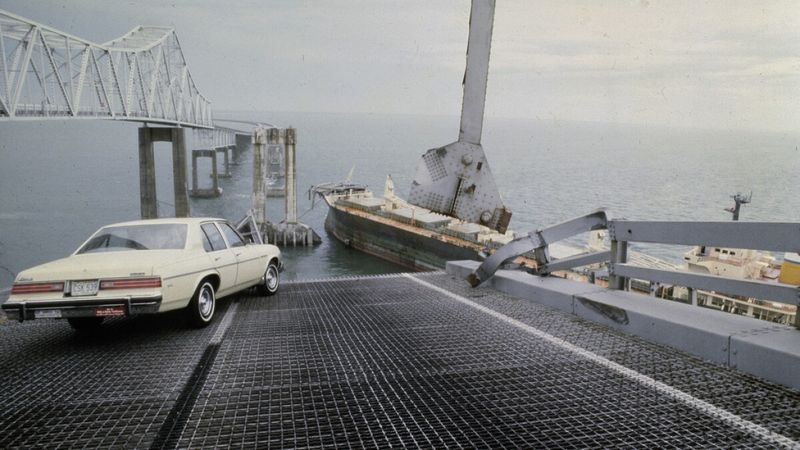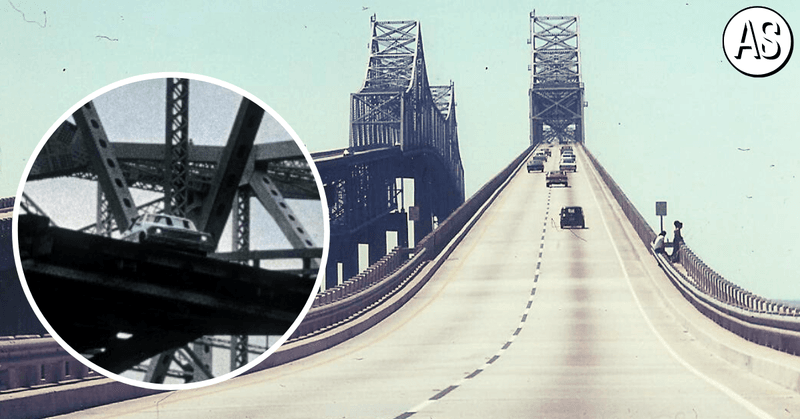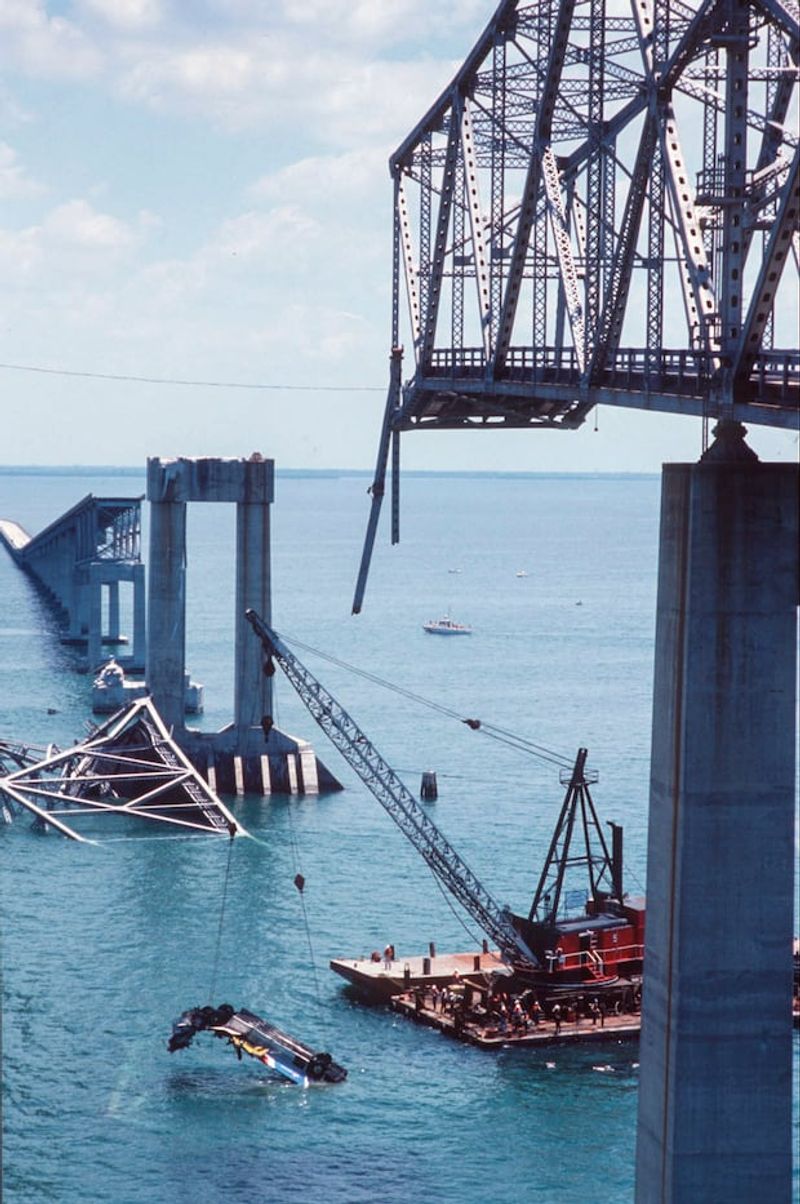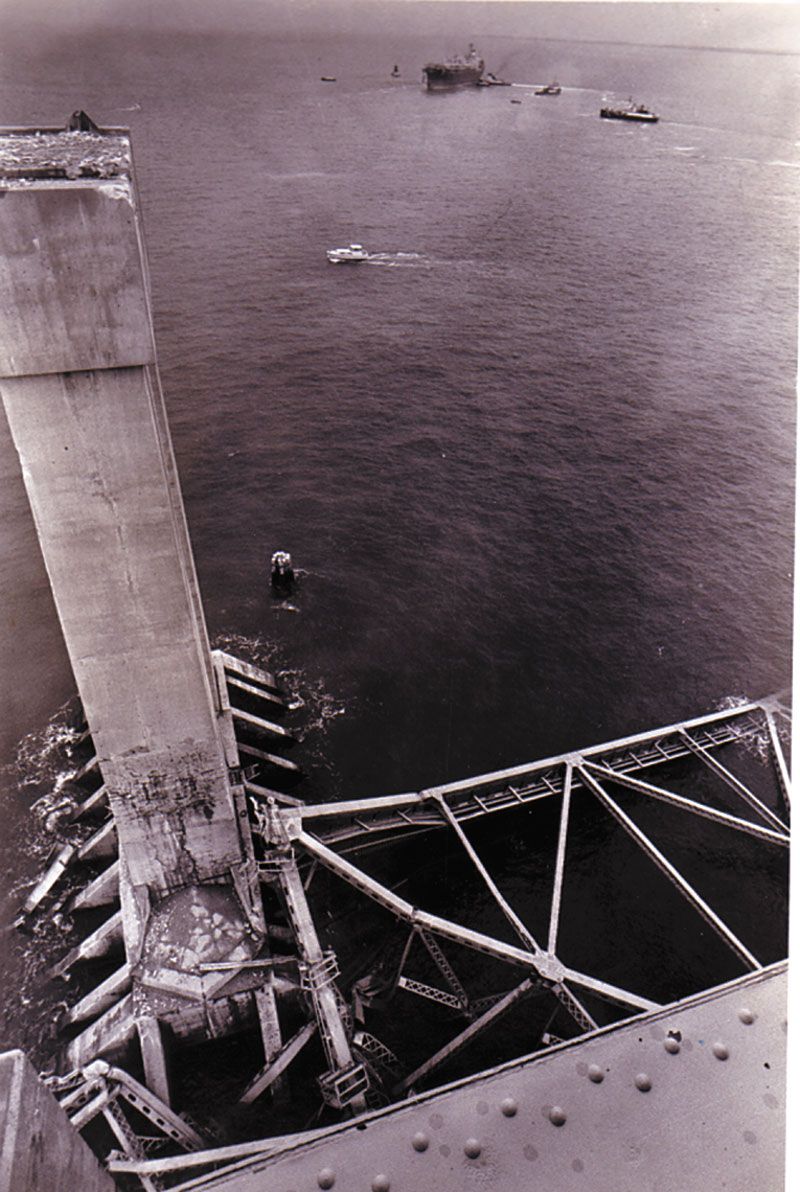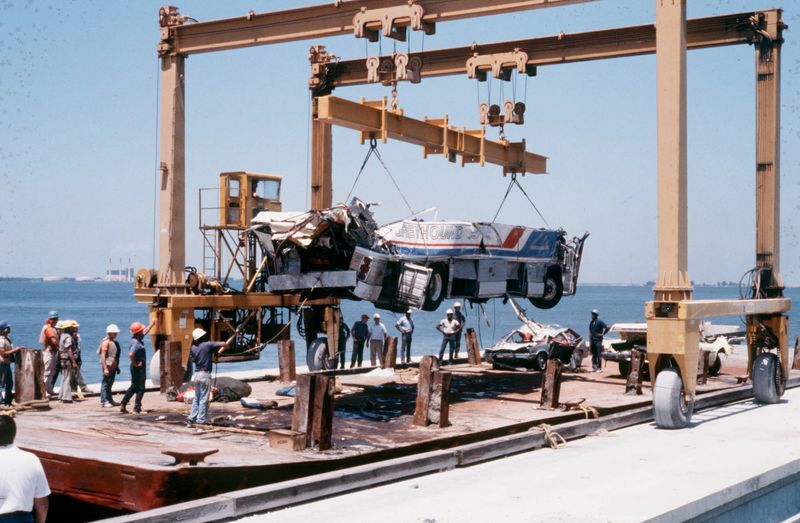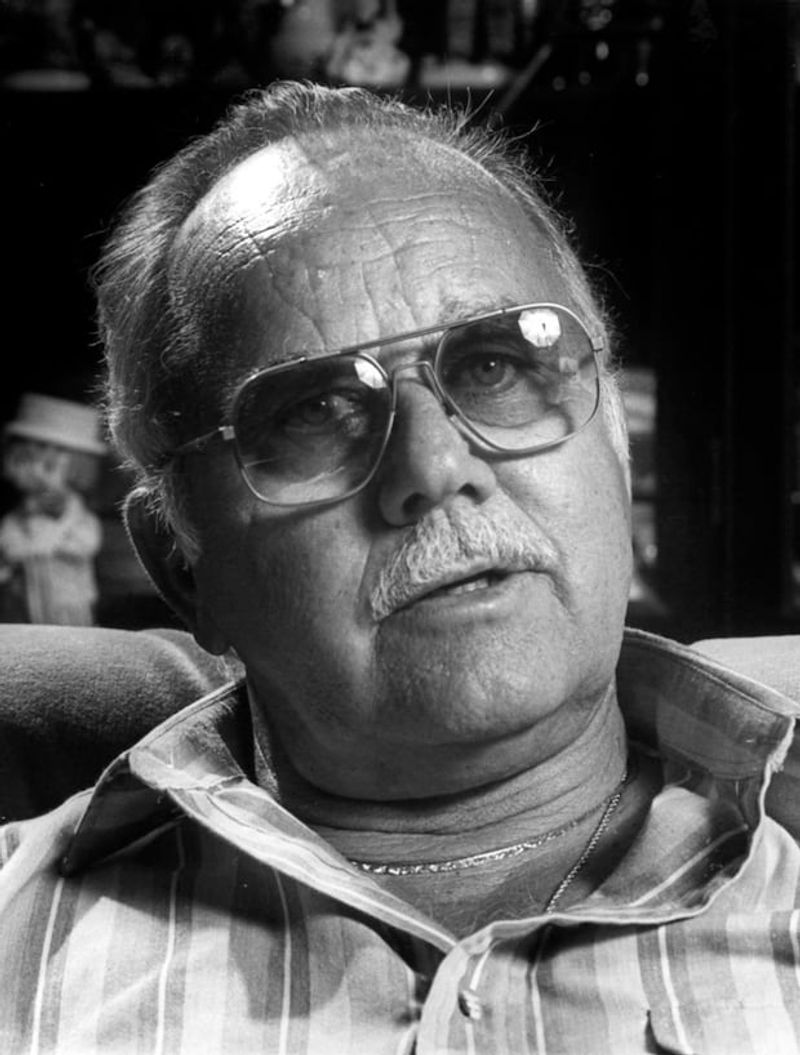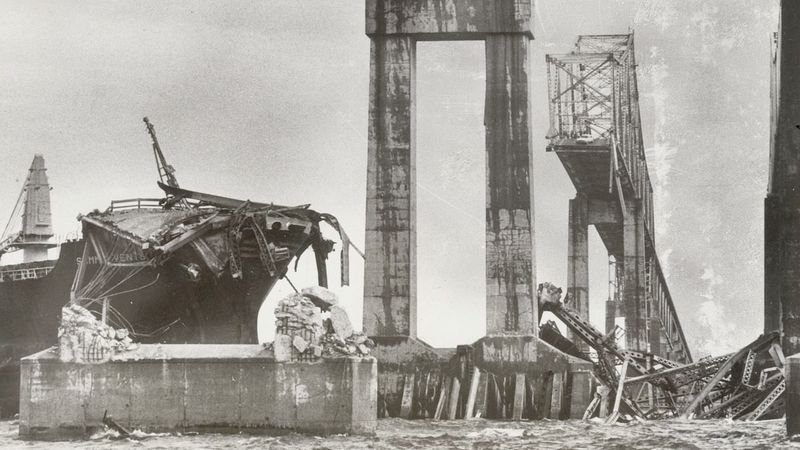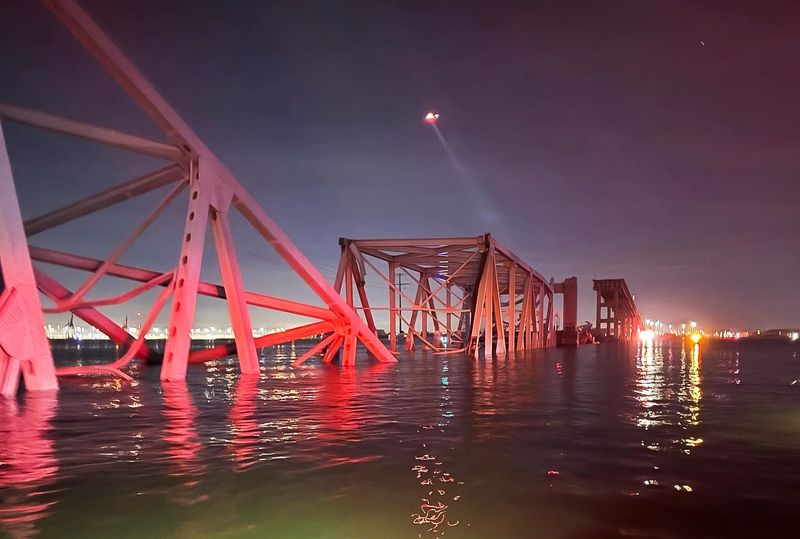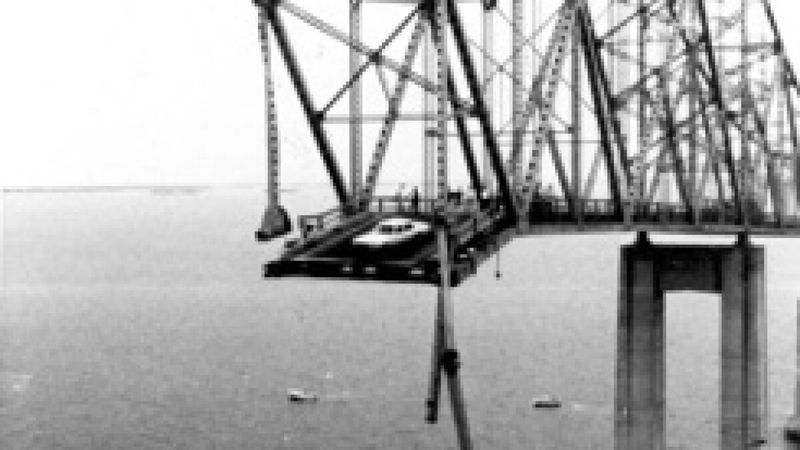On a stormy morning in May 1980, Florida’s Sunshine Skyway Bridge became the scene of unimaginable tragedy. When the freighter MV Summit Venture slammed into a support column during a blinding squall, a massive section of the bridge plunged into Tampa Bay below. The catastrophe claimed 35 lives and forever changed how America builds bridges, leaving behind stories of heartbreak, heroism, and haunting what-ifs.
1. The Swift Destruction
One moment, cars were crossing Tampa Bay on their morning commute. The next, the world collapsed beneath them. The entire catastrophe unfolded in mere minutes, beginning at 7:38 a.m. when the Summit Venture struck the bridge’s support column.
Within seconds, a 1,200-foot section of concrete and steel roadway crumbled like a child’s toy. Motorists had no warning, no time to react or reverse course. The violence and speed of the collapse meant that many victims likely never understood what was happening as their vehicles pitched forward into the abyss.
2. Lives Lost in an Instant
The human toll was staggering—35 souls vanished that morning. Six cars, a pickup truck, and a Greyhound bus plummeted more than 150 feet into the churning waters below. Mothers, fathers, college students, retirees—ordinary people on ordinary journeys.
Among the victims was a young woman heading to her wedding rehearsal. Another was a father of four traveling for work. The randomness of who happened to be crossing at that exact moment haunts survivors’ families to this day. Their stories remain etched in the collective memory of the Tampa Bay community.
3. The Doomed Greyhound
Route 4508 was supposed to be just another morning journey for the Miami-bound Greyhound bus. Driver Robert Curran had no way of knowing he was steering his passengers toward disaster as the bus approached the bridge’s highest point.
Twenty-six passengers from all walks of life—retirees heading south, workers commuting to jobs, students returning to school—sat aboard. Personal effects later recovered told heartbreaking stories: a gift-wrapped present, a half-finished letter, vacation photographs. All 26 passengers and their driver perished together when the bus plunged over the edge.
4. Rush Hour Timing
Morning commuters were just beginning to fill the roadways when disaster struck. Traffic flow was still relatively light at 7:38 a.m., with the heaviest rush hour surge expected around 8:00-8:30 a.m.
Engineers later calculated that had the collision occurred just 30 minutes later, the death toll could have multiplied several times over. Up to 200 additional vehicles might have been crossing the span during peak traffic. While devastating as it was, many consider the timing a grim stroke of fortune that prevented the tragedy from claiming hundreds more lives.
5. Blinded by Nature’s Fury
Captain John Lerro faced a pilot’s nightmare that morning. Steering the massive freighter through Tampa Bay, he suddenly found himself engulfed in a violent squall that materialized with frightening speed.
Visibility plummeted from miles to mere feet in seconds. Radar became unreliable in the heavy rain. Radio communications crackled with static. The captain later testified that the storm’s intensity was unlike anything he’d experienced in his maritime career.
Fighting blinding rain and powerful winds, Lerro lost his bearings just long enough for catastrophe to strike—a momentary disorientation with permanent consequences.
6. The Man Who Tried to Warn Others
Richard Hornbuckle, a 56-year-old truck driver, realized something was terribly wrong seconds before disaster. Witnesses reported seeing his hazard lights flashing and his arms waving frantically out the window, trying to warn approaching vehicles.
His CB radio captured his final words: “The bridge is going! Get back!” Despite his efforts, oncoming traffic couldn’t stop in time on the rain-slicked roadway. Hornbuckle’s truck plunged with the collapsing span, his final act one of desperate heroism.
His family later received letters from strangers who had turned around after seeing his warnings.
7. The Sole Survivor
Wesley MacIntire’s survival defies explanation. His pickup truck sailed over the broken edge of the bridge, but instead of plummeting directly into the water, it struck the side of the Summit Venture first, absorbing some impact.
MacIntire was thrown from his vehicle into Tampa Bay. Despite injuries and the shock of the fall, he managed to stay afloat until rescued. “I remember falling and thinking ‘This is it,'” he later recounted.
The burden of being the disaster’s only survivor weighed heavily on him. MacIntire lived another nine years but friends said he never fully recovered from the psychological trauma.
8. The Massive Ship That Changed Everything
The MV Summit Venture was a behemoth of engineering—a 608-foot bulk carrier weighing over 19,700 tons. For perspective, the ship stretched longer than two football fields placed end-to-end.
Built in 1976, she was considered modern and well-equipped for her time. The vessel’s massive bow rose seven stories above the waterline when fully loaded. When this floating skyscraper struck the bridge support at approximately 8 knots, the impact delivered force equivalent to several tons of explosives.
The ship sustained damage but remained seaworthy, becoming an unwitting monument to the tragedy.
9. An Outdated Design Meets Modern Shipping
The original Sunshine Skyway Bridge opened in 1954, designed for a different era of maritime traffic. Engineers created the span when ships were smaller and fewer in number, with support columns placed for the vessels of that time.
By 1980, global shipping had transformed dramatically. Freighters had grown massively in size and draft, yet the bridge’s narrow shipping channel and exposed supports remained unchanged. Maritime experts had warned about the potential danger for years.
The bridge’s design flaws became tragically apparent that May morning—an aging structure unable to accommodate the realities of modern commerce.
10. Rescue Efforts Hampered by Nature
First responders faced a nightmare scenario. The continuing storm created treacherous conditions for rescue boats and divers as they raced to the scene. Churning waters, poor visibility, and dangerous debris hampered every effort.
Coast Guard helicopters hovered above, spotting victims but struggling to maintain position in gusty winds. By the time specialized dive teams arrived, most victims had been underwater too long for survival.
The recovery operation lasted days, with divers working in shifts to locate vehicles and bodies. The psychological toll on rescue workers was immense—many later required counseling to process what they had witnessed.
11. Engineering Revolution Born from Tragedy
The disaster sparked a nationwide reassessment of bridge safety. Engineers studied the collapse extensively, developing new protective systems that would become standard across America.
Concrete “dolphins”—massive protective barriers designed to absorb ship impacts—now shield bridge supports around the world. Modern navigation systems, improved storm warnings, and enhanced pilot training all emerged from lessons learned.
The tragedy transformed bridge architecture forever, with newer spans featuring wider navigation channels and better-protected support structures. The Sunshine Skyway disaster, while devastating, likely prevented future catastrophes through the safety innovations it inspired.
12. The Captain’s Burden
John Lerro was legally exonerated after extensive hearings determined the storm’s sudden intensity was the primary factor in the accident. Yet public opinion proved harsher than the courts. Hate mail arrived daily; strangers confronted him in public.
“I relive it every day,” Lerro confessed in a rare interview. “I see their faces.” He battled depression and eventually multiple sclerosis, living his remaining years in relative isolation. Former colleagues described him as a skilled pilot haunted by circumstances beyond his control.
When Lerro died in 2002, several families of victims attended his funeral—a testament to forgiveness and the shared tragedy that connected them.
13. Dismantling a Painful Landmark
The remaining sections of the original bridge stood as eerie reminders of the tragedy for years. Engineers determined that the entire structure had been compromised beyond safe repair.
Demolition began in 1991, requiring specialized techniques to prevent further environmental damage to Tampa Bay. Controlled explosions brought down some sections, while others were carefully dismantled piece by piece.
Rather than completely removing all traces, Florida made a unique decision. The approaches on both sides were preserved as fishing piers, allowing the structure to serve a new purpose while acknowledging its painful history—a place of recreation built from the remnants of disaster.
14. A Modern Marvel Rises
The replacement bridge opened in 1987, representing the pinnacle of modern engineering. Its distinctive yellow cables and soaring design quickly became a new symbol for the Tampa Bay region.
Engineers incorporated every safety lesson from the disaster. The new span features a channel width of 1,200 feet—quadruple the original—and massive protective islands shield all supports. Advanced lighting, weather monitoring, and navigational aids provide additional layers of protection.
The new Sunshine Skyway stands as one of America’s most beautiful bridges and also one of its safest, a phoenix that rose from tragedy to become an award-winning structure admired worldwide.
15. Annual Remembrance
Every May 9th, families gather at the fishing pier that once formed part of the original bridge. They bring flowers, photographs, and memories of loved ones lost that stormy morning.
A memorial plaque lists all 35 names, with special ceremonies marking significant anniversaries. Some families release flowers into the water below; others simply stand in quiet contemplation. Coast Guard vessels often participate, sounding horns in tribute.
Local fishermen observe a moment of silence when passing the accident site, a tradition passed down through generations. The annual remembrance ensures that those who perished are never forgotten, their stories woven permanently into Tampa Bay’s history.

